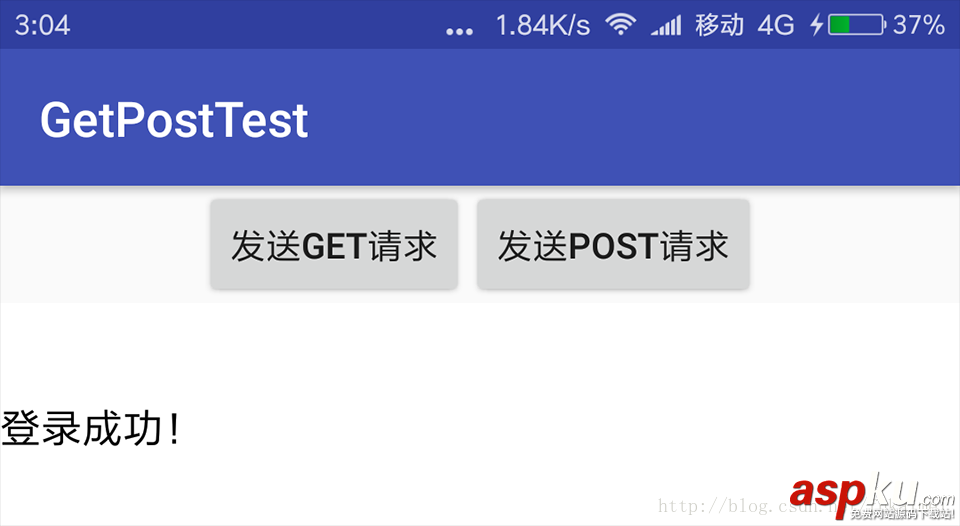URL的openConnection()方法將返回一個URLConnection對象,該對象表示應(yīng)用程序和URL之間的通信連接。程序可以通過URLConnection實例向該URL發(fā)送請求,讀取URL引用的資源。
通常創(chuàng)建一個和URL的連接,并發(fā)送請求、讀取此URL引用的資源需要如下幾個步驟:
Step1: 通過調(diào)用URL對象的openConnection()方法來創(chuàng)建URLConnection對象;
Step2:設(shè)置URLConnection的參數(shù)和普通請求屬性;
Step3:如果只是發(fā)送GET方式的請求,那么使用connect方法建立和遠程資源之間的實際連接即可;如果需要發(fā)送POST方式的請求,則需要獲取URLConnection實例對應(yīng)的輸出流來發(fā)送請求參數(shù);
Step4:遠程資源變?yōu)榭捎茫绦蚩梢栽L問遠程資源的頭字段,或通過流入流讀取遠程資源的數(shù)據(jù)。
下面的程序Demo示范了如何向Web站點發(fā)送GET請求、POST請求,并從Web站點取得響應(yīng)。該程序中用到一個GET、POST請求的工具類,該類代碼如下:
GetPostUtil.java邏輯代碼如下:
package com.fukaimei.getposttest;import android.util.Log;import java.io.BufferedReader;import java.io.IOException;import java.io.InputStreamReader;import java.io.PrintWriter;import java.net.URL;import java.net.URLConnection;import java.util.List;import java.util.Map;/** * Created by FuKaimei on 2017/10/2. */public class GetPostUtil { private static final String TAG = "GetPostUtil"; /** * 向指定URL發(fā)送GET方式的請求 * * @param url 發(fā)送請求的URL * @param params 請求參數(shù),請求參數(shù)應(yīng)該是name1=value1 & name2=value2的形式 * @return URL所代表遠程資源的響應(yīng) */ public static String sendGet(String url, String params) { String result = ""; BufferedReader in = null; try { String urlName = url + "?" + params; URL realUrl = new URL(urlName); // 打開和URL之間的連接 URLConnection conn = realUrl.openConnection(); // 設(shè)置通用的請求屬性 conn.setRequestProperty("accept", "*/*"); conn.setRequestProperty("connection", "Keep-Alive"); conn.setRequestProperty("user-agent", "Mozilla/4.0 (compatible; MSIE 6.0; Windows NT 5.1; SV1)"); // 建立實際的連接 conn.connect(); // 獲取所有的響應(yīng)頭字段 Map<String, List<String>> map = conn.getHeaderFields(); // 遍歷所有的響應(yīng)頭字段 for (String key : map.keySet()) { Log.d(TAG, key + "---->" + map.get(key)); } // 定義BufferedReader輸入流來讀取URL的響應(yīng) in = new BufferedReader(new InputStreamReader(conn.getInputStream())); String line; while ((line = in.readLine()) != null) { result += "/n" + line; } } catch (Exception e) { Log.d(TAG, "發(fā)送GET請求出現(xiàn)異常!" + e); e.printStackTrace(); } finally { // 使用finally塊來關(guān)閉輸入流 try { if (in != null) { in.close(); } } catch (IOException e) { e.printStackTrace(); } } return result; } /** * 向指定URL發(fā)送POST方式的請求 * * @param url 發(fā)送請求的URL * @param params 請求參數(shù),請求參數(shù)應(yīng)該是name1=value1 & name2=value2的形式 * @return 所代表遠程資源的響應(yīng) */ public static String sendPost(String url, String params) { PrintWriter out = null; BufferedReader in = null; String result = ""; try { URL realUrl = new URL(url); // 打開和URL之間的連接 URLConnection conn = realUrl.openConnection(); // 設(shè)置通用的請求屬性 conn.setRequestProperty("accept", "*/*"); conn.setRequestProperty("connection", "Keep-Alive"); conn.setRequestProperty("user-agent", "Mozilla/4.0 (compatible; MSIE 6.0; Windows NT 5.1; SV1)"); // 發(fā)送POST請求必須設(shè)置如下兩行 conn.setDoOutput(true); conn.setDoInput(true); // 獲取URLConnection對象對應(yīng)的輸出流 out = new PrintWriter(conn.getOutputStream()); // 發(fā)送請求參數(shù) out.print(params); // flush輸出流的緩存 out.flush(); // 定義BufferedReader輸入流來讀取URL的響應(yīng) in = new BufferedReader(new InputStreamReader(conn.getInputStream())); String line; while ((line = in.readLine()) != null) { result += "/n" + line; } } catch (Exception e) { Log.d(TAG, "發(fā)送POST請求出現(xiàn)異常!" + e); e.printStackTrace(); } finally { // 使用finally塊來關(guān)閉輸出流、輸入流 try { if (out != null) { out.close(); } if (in != null) { in.close(); } } catch (IOException e) { e.printStackTrace(); } } return result; }} 從上面的程序Demo可以看出,如果需要發(fā)送GET請求,只要調(diào)用URLConnection的connect()方法去建立實際的連接即可。如果需要發(fā)送POST請求,則需要獲取URLConnection的OutputStream,然后再向網(wǎng)絡(luò)中輸出請求參數(shù)。
提供了上面發(fā)送GET請求、POST請求的工具類之后,接下來就可以在Activity類中通過該工具類發(fā)送請求了。該程序的界面中包含兩個按鈕,一個按鈕用于發(fā)送GET請求,一個按鈕用于發(fā)送POST請求。程序還提供了一個EditText來顯示服務(wù)器的響應(yīng)。
layout/activity_main.xml界面布局代碼如下:
<?xml version="1.0" encoding="utf-8"?><LinearLayout xmlns:android="http://schemas.android.com/apk/res/android" android:layout_width="match_parent" android:layout_height="match_parent" android:orientation="vertical"> <LinearLayout android:layout_width="match_parent" android:layout_height="wrap_content" android:gravity="center" android:orientation="horizontal"> <Button android:id="@+id/get" android:layout_width="wrap_content" android:layout_height="wrap_content" android:text="發(fā)送GET請求" /> <Button android:id="@+id/post" android:layout_width="wrap_content" android:layout_height="wrap_content" android:text="發(fā)送POST請求" /> </LinearLayout> <TextView android:id="@+id/show" android:layout_width="match_parent" android:layout_height="match_parent" android:background="#ffff" android:gravity="top" android:textColor="#f000" android:textSize="16sp" /></LinearLayout>
MainActivity.java邏輯代碼如下:
package com.fukaimei.getposttest;import android.os.Handler;import android.os.Message;import android.support.v7.app.AppCompatActivity;import android.os.Bundle;import android.view.View;import android.widget.Button;import android.widget.TextView;public class MainActivity extends AppCompatActivity { Button get, post; TextView show; // 代表服務(wù)器響應(yīng)的字符串 String response; Handler handler = new Handler() { @Override public void handleMessage(Message msg) { if (msg.what == 0x123) { // 設(shè)置show控件服務(wù)器響應(yīng) show.setText(response); } } }; @Override protected void onCreate(Bundle savedInstanceState) { super.onCreate(savedInstanceState); setContentView(R.layout.activity_main); get = (Button) findViewById(R.id.get); post = (Button) findViewById(R.id.post); show = (TextView) findViewById(R.id.show); get.setOnClickListener(new View.OnClickListener() { @Override public void onClick(View v) { new Thread() { @Override public void run() { response = GetPostUtil.sendGet("https://www.mi.com/", null); // 發(fā)送消息通知UI線程更新UI組件 handler.sendEmptyMessage(0x123); } }.start(); } }); post.setOnClickListener(new View.OnClickListener() { @Override public void onClick(View v) { new Thread() { @Override public void run() { response = GetPostUtil.sendPost("http://172.xx.xx.xxx:8080/fukaimei/login.jsp", "name=android&pass=123"); } }.start(); // 發(fā)送消息通知UI線程更新UI組件 handler.sendEmptyMessage(0x123); } }); }}上面程序Demo中用于發(fā)送GET請求、POST請求。從上面的代碼可以發(fā)現(xiàn),借助于URLConnection類的幫助,應(yīng)用程序可以非常方便地與指定站點交換信息,包括發(fā)送GET請求、POST請求,并獲取網(wǎng)站的響應(yīng)等。
注意:由于該程序需要訪問互聯(lián)網(wǎng),因此還需要在清單文件AndroidManifest.xml文件中授權(quán)訪問互聯(lián)網(wǎng)的權(quán)限:
<!-- 授權(quán)訪問互聯(lián)網(wǎng)--> <uses-permission android:name="android.permission.INTERNET" />
Demo程序運行效果界面截圖如下:


以上就是本文的全部內(nèi)容,希望對大家的學(xué)習(xí)有所幫助,也希望大家多多支持VEVB武林網(wǎng)。
新聞熱點
疑難解答
圖片精選